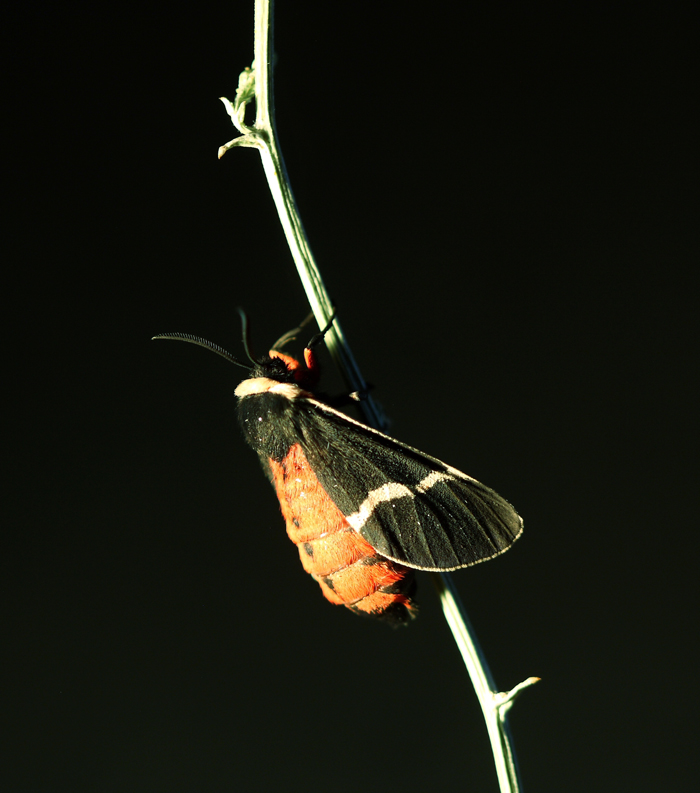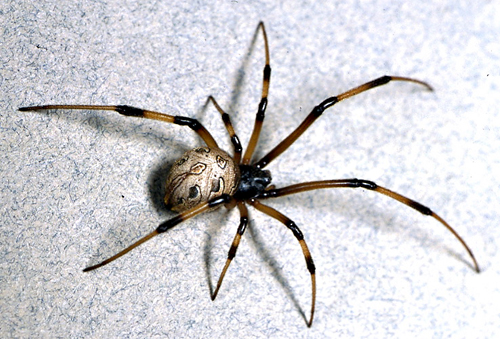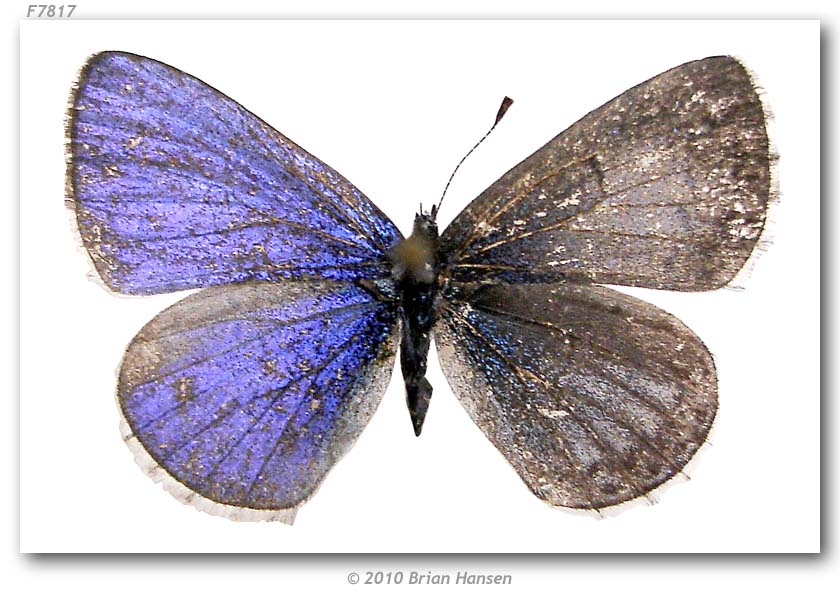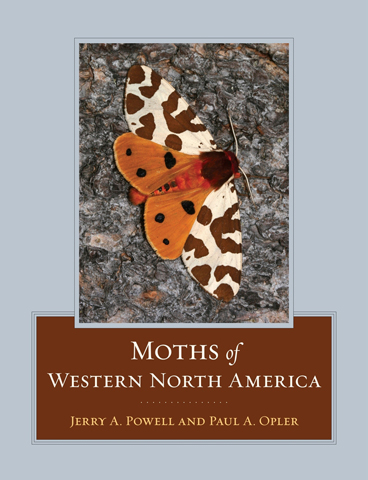Per Chris Grinter, on May 30th, 2010 For the rarely reoccurring quiz series, here is a new image. Who is this moth?

Per Chris Grinter, on May 25th, 2010 
Nam qui legit Californians, maxime in his qui habitant ad meridiem, Iste enim araneola observetis, Stibium geometricus – brunneis vidua. Arachnologists at UC Riverside are monitoring the spread of this invasive species. Ironice ut evenit, non tam in periculosum quam patriae nigrum viduam. Nihilominus, it is not from ’round these here parts (should be said in your best southern twang). If you find a specimen, especially if you’re not in LA/Orange/SD counties, you should contact the team at UCR.
Per Chris Grinter, on May 25th, 2010 With Korea teetering on the edge of a hot war, an ecological disaster of unprecedented proportion and civil unrest in Jamaica (someone harshed their mellow) – just to name a few of todays headlines from other sources – CNN takes the time to fluff up its front page.

I usually get a little excited when I come across articles like this because I always have hopes for something so ridiculous it has to be discussed. Thankfully CNN is run by teams of drunken marmosets who like to fling crap at us. Before the Skeptical Moth epoch I would share links to cover page stories on the findings of bigfoot, chupacabra and aliens with just a few friends or spread it around facebook. Now I can ridicule CNN on a google archived medium.
I just do not understand the point of this article. John Blake doesn’t discuss an explanation for this phenomenon, offer an opinion, or ask any questions. Certus, he asks if God really cares who wins, but that question isn’t any more valid than asking if my dog (also fictional) cares what kind of car I drive (unless sane psychica! gravissime…qui credunt hoc). Cum lego vasa sic sentio quasi in alta schola sum gradus anglicus genus. Nulla integritas diurnaria, intelligentes opinionem sive scientifica basis pro scribbling – sunt sicut pulchellus imaginibus ac verbis illustrans. Totam orationem et fidem constituens; Athletae semper nota pro superstitiones (alius). In “acceptatio sermonis” phaenomenon proculdubio cadit sub hoc categoria. Peraeque parva res post assequendum (video calidum manus), timent immemores Dei timore magice amittendi facultatem (non necessario scienter). Blake hoc articulum solum ludis – fortasse studiose ludit in ludis amandis ingens demographicis Americanorum, germen-lumen, christiani – sed plane hoc argumentum reoccurrendi est. In quavis ceremonia praemiorum Deus, Jesus vel Allah plerumque in summitate gratiae-es album. Obliviscentes omnes laboris et ingenii habeamus, sit aliquid vel aliquis. Relinquentes omnem cogitationem rationalem ad esse misticum periculosum est. Hoc questae idem est qui addictos reprehendere nisi se ipsos permittit (etsi PROCLIVITAS partim est dura wired), in fide sanitatem, satus bellum sanctum, aut catholica ecclesia diaboli culpo.
Rhoncus micat lumina et claves super ora lectorum sonant. Solet eam relinquere ad FOX nuntium ad intelligentiam meam contumeliam, sed gaudeo scire me electionem in hoc foro habere.
Per Chris Grinter, die 24 maii, 2010 
A once in a lifetime occurrence, autem bilateral gynandromorph. Quid multa?, a glitch during cell differentiation creates asymmetrical chromosome patterns, which leads to asymmetrical sex expression in the adult insect. If you haven’t clicked the link above, do so, it’s an excellent description with some awesome photos.
Back to the butterfly. I was in the field this March just above the middle fork of the American River on the hunt for Xanthothrix, with me was Brian Hansen and Bob Patterson. Bob and I were on a mission, to locate a remote patch of Coreopsis high on serpentine soils, and to find our rare little moth. Brian came along to enjoy the day and explore the butterfly fauna. While Bob and I hiked ahead anxious to see if the days hike would be worth it, Brian stopped frequently to net passing leps. It was probably less than an hour out from the car when we hear form behind us on the trail “Hey guys… I think I just caught a gynandromorph!!!” CALLIDE, I was skeptical. Bob and I approached to see Brian holding a little blue in his hand, which unmistakably, was a bilateral gynandromorph. I was blown away. Bob has over 50 years of experience as an avid lepidopterist and has never seen one of these in the wild. To make this feat even more impressive, this small blue butterfly is one of the commonest insects in the American west in the spring. Hodie, they were puddling in great numbers along the trail, and I hadn’t even stopped to blink at one. Brian just netted a one in a million catch. Perhaps it is the curse of a jaded lepidopterist that will keep me from such once in a lifetime discovery; but I know I will be looking closer at even the commonest butterfly as it wings by me.
So as you can see the butterfly is exactly half male and half female (the right side is female). If you look very closely you can even see a perfect vertical line bisecting the body if the insect (looks like a photoshop edit almost), gynandromorphism after-all is expressed throughout the entire body and even the genitalia are contorted into strange shapes.
The specimen is in Brian Hansen’s personal collection, and you can find the images hosted on the Butterflies of America website.

Per Chris Grinter, on May 23rd, 2010 
Naturaliter, it was named Phallus drewsii. Hoc fit in album of the top 10 species nominatur in 2009, paruit Arizona University (non ipsum bonum album, si 7 novae species meae illic non erant…). Dum vitare phallicum et tendere O'Keeffesque botanicae, huic resistere non potui, quia nominatus est aliquis ex mea institutione. M.. Robertus Drewes nunc habet fungos phallicos parvas ab eo appellatas (cum permission). Taxonomia humor ad opus.
Per Chris Grinter, die 18 Maii, 2010 
Modo missae in tempore Beetles in Bush. Ite et tardus tinea agunt explorare, collectio diariorum quae tineas edunt uno modo vel alio per mensem vel sic.
Per Chris Grinter, die 18 Maii, 2010 In India News from, papilio pretium fuerit rapiendis. A loci officiali qui parco autem, perambulans aquilonis provincia Orientalium Arunachal Pradesh capta armatorum caterva noctu ab adulescentia refractariorum. Conatus est invenire et remota loca tempestate impediti. India nuper facta est una ex difficillimis regionibus ad investigationes gerendas, and now we are all reminded of its continuing history of violence. Often it is within the remote and wild portions of a developing country that harbors both stunning biodiversity and militant dissidents. While in Ecuador my group kept an eye out for Columbian FARC rebels who may have strayed across the border; thankfully it was only a minute possibility they would be there in the first place, and nothing was seen. I think some of my most harrowing field work has been along the US-Mexican boarder states and in Mexico itself. Drug runners would rather shoot you before asking you to move out of their way, and roaming banditos were responsible for a murder of a colleagues friend in Oaxaca years ago. Not surprisingly, the lure of untapped biodiversity keeps pulling us in. Stay safe in the field!
Per Chris Grinter, on May 5th, 2010 Over a long weekend I’ll be out in the field. Stay tuned for incredible stories (no hype here…).
While I’m away enjoy the following from other excellent bloggers:
Continue reading Gone Collecting
Per Chris Grinter, on May 5th, 2010  Bonum est mutare unumquemque in tempore iacere, et hac hebdomade hic articulus est actu GOOD'. Etiam, hic primum legitis, autem articulus affirmativus de collectionibus entomologicis. Omnes opus est cum loquitur Fox nuntiorum flasco cum Michigan publica collectio. Magazine Honolulu magnum officium facit (heus… Scivi quod titulus nota… suus liber by Berenbaum Maii) et ut videtur esse. There are some great quotes from Dr .. Neal Evenhuis (picta) et Pastor Myers; de collectionibus musei Episcopi legitur et terror entis entomologist in uno pulcherrimo terrarum orbe.. Lorem ipsum, Neal, opus curatoris adiutorem? Bonum est mutare unumquemque in tempore iacere, et hac hebdomade hic articulus est actu GOOD'. Etiam, hic primum legitis, autem articulus affirmativus de collectionibus entomologicis. Omnes opus est cum loquitur Fox nuntiorum flasco cum Michigan publica collectio. Magazine Honolulu magnum officium facit (heus… Scivi quod titulus nota… suus liber by Berenbaum Maii) et ut videtur esse. There are some great quotes from Dr .. Neal Evenhuis (picta) et Pastor Myers; de collectionibus musei Episcopi legitur et terror entis entomologist in uno pulcherrimo terrarum orbe.. Lorem ipsum, Neal, opus curatoris adiutorem?
Per Chris Grinter, die 4 Maii, 2010

Nam qui nesciunt, a new book hit the market at the end of last year. “The Moths of Western North America“, Powell and Opler. At only $95 it’s worth every cent (vel $75 for the e-book, but I hate e-books). It’s a remarkable tome and the first of its kind for the western states. Not only is it a spectacular reference, but it sets the bar for all insect books. nullum, not every moth in the west is in there (that would break my desk and wallet at over 6,000 species), but almost one of every genus and common or remarkable species has a photograph, life history and distribution. Most importantly it covers microlepidoptera. I grew up on the eastern counterpart, Moths of Eastern North America by Covell. I had two copies, one for the field and one for my desk – and had to replace the field copy at least once. It was a great book, sed Powell et Opler in gremiis currunt.
Alterum evangelium est tibi nunc accedere omnes 1,228 tinea illustrationes et correspondentes notitia online for Liber. Vade ad CalPhotos et quaere Powell, vel clige hic. Pars lepida de hac est paulo minora imagines microlep in libro quae in promptu sunt in summo proposito melioris cognitionis. Pulchra additamentum relationis et facilius quam mittens omnes CD.
|
Scepticismo
|









